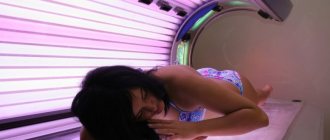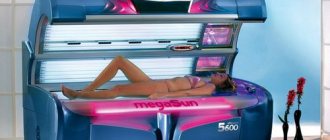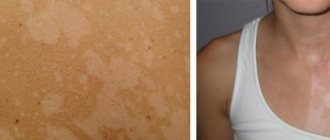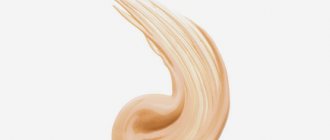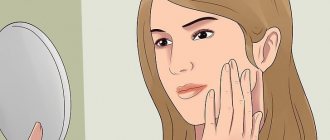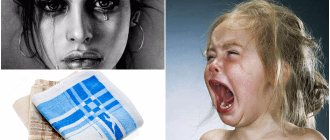A solarium is a horizontal or vertical platform for irradiation with light from ultraviolet lamps. Tinted glass, which is used in tanning salons, does not transmit the short-wave part of the UV spectrum, which poses a health hazard. But frequent tanning procedures sometimes lead to damage to the skin. A tanning burn is characterized by the destruction of cells in the superficial and deeper layers of the skin. Treatment methods depend on the area of damage and the depth of penetration of the rays into the soft tissue.
Why is ultraviolet burn dangerous?
Tanning bed burns occur due to increased sensitivity of the skin to UV radiation. This condition is called the photosensitivity effect. During sun exposure, the protein components of the skin are destroyed, and their breakdown products enter the bloodstream. Under the influence of rays, the functioning of internal organs is disrupted, and dangerous diseases arise:
- photodermatitis;
- depression of the functions of the central nervous system;
- increased fat metabolism;
- malignant tumors;
- clouding of the lens of the eye;
- conjunctivitis.
Frequent visits to solariums are fraught with cancer - melanoma, squamous cell carcinoma.
How to remove redness on the skin after tanning
Mild redness can be dealt with using the simplest methods that do not require the use of special drugs. Actions in this case may be as follows.
- Taking a shower. Yes, the first priority is to get rid of any tanning products that were previously applied to your skin. The water in the shower should not be too hot or cold. It is better if its temperature is neutral or corresponding to body temperature. To quickly and completely wash your skin of cosmetics and impurities, just use a simple shower gel. Only it should be without menthol and other stimulating components in the composition.
- Application of vegetable oil. It should be emphasized right away that oil itself does not relieve redness and, moreover, burns. On the contrary, it creates a poorly permeable film that prevents the body temperature in the damaged area from decreasing. But you can still relieve pain with it. To do this, you need to apply any vegetable oil to the skin for about 15–20 minutes, rub it gently, and then rinse off. Under no circumstances should the applied composition be left on the skin.
- Treatment of skin with cosmetics. Almost any cosmetic product intended to moisturize the skin is appropriate. It is applied to the body, waits for absorption and is not washed off. In this case, a lotion or milk that has a mild effect is suitable.
The first symptoms of a burn after a solarium
The clinical manifestations of sunburn are not much different from damage caused by UV rays from the sun. The severity of symptoms depends on the duration of the procedure and the frequency of visits to the solarium. Exposure to UV radiation increases the use of certain medications - antibiotics, hormonal agents, antipsychotics, herbal antidepressants. Substances that affect photosensitivity are even found in food products - greens, fresh vegetables, citrus fruits.
It is advisable for anyone who goes to a solarium to visit a doctor and get the necessary advice from a dermatologist or cosmetologist. Such actions will certainly help prevent troubles in the future.
People with fair skin types are more susceptible to radiation injuries. This is due to the low amount of melanin in the body, which protects the skin from aggressive UV radiation. The primary manifestations of a burn from tanning include:
- redness and peeling of the skin;
- moderate to severe itching;
- swelling;
- local temperature increase;
- headache;
- weakness;
- nausea.
Redness after tanning indicates the destruction of cells in the stratum corneum of the epidermis. The retina of the eye also suffers from bright UV radiation. With frequent sun exposure, patients complain of:
- conjunctival irritation;
- burning;
- lacrimation;
- photophobia;
- swelling of the eyelids;
- pain when touched, etc.
In isolated cases, hemorrhages occur in the eyeball, leading to damage and detachment of the retina. This is fraught with decreased visual acuity, partial blindness, and infectious inflammation.
In 86% of cases, people get superficial burns of 1st and 2nd degree in a solarium. If the cells of the germ layer of the skin are destroyed, bubbles with a clear liquid form on the body. Healing occurs within 1.5-2 weeks subject to adequate treatment.
How to avoid getting burned
To prevent sunburn burns, follow these tips:
- It is necessary to gradually increase the time spent in the solarium, starting from 2 minutes. If there are no side effects, you can increase the time with the next procedure, bringing it up to 10 minutes.
- In addition, you need to start tanning with a low level of ultraviolet radiation intensity.
- Before going to the solarium, you need to apply special sunscreens designed specifically for this procedure over the entire surface of your skin.
- After tanning, be sure to apply moisturizers to the skin, and when the first signs of burns appear, medications to restore damaged cells.
- After the procedure, it is not recommended to use scrubs or perform other peeling procedures.
- Before tanning, you should not take a shower or do intensive skin cleansing procedures.
- You should not enter the solarium with cosmetics that contain alcohol and chemical compounds.
Rules for tanning in a solarium
Basic rules for tanning in a solarium:
- You need to start sunbathing in a solarium with minimal doses, namely with low intensity ultraviolet rays and up to 2 minutes.
- A few minutes before the procedure, apply sunscreen intended for solariums to exposed skin. The selection of products should take into account your skin type.
- Be sure to protect your head with a special cap, your eyes with glasses, your chest with special pads and your bikini area.
- We apply a special balm with sun protective filters to our lips.
- Before the procedure, it is recommended to use scrubs and chemical peeling of the skin.
- The skin should be clean without the use of cosmetics, especially those containing alcohol.
- After tanning, apply moisturizers to the skin.
- After the procedure, you cannot carry out any manipulations to cleanse the skin.
What to do if you are burned in a solarium: first aid
Burns after solarium are dangerous due to a general deterioration in well-being. This occurs due to poisoning by protein breakdown products contained in the skin. In case of extensive injuries, the victim is provided with emergency care using anti-burn and painkillers. Timely treatment of injured tissue prevents deepening of the wound and complications.
Skin damage
At the first sign of a burn, you must:
- Cool damaged skin areas. Cold showers keep tissues cool. To wash off the remnants of tanning cosmetics, use a hypoallergenic gel or tar soap.
- Take painkillers. In case of a severe burn, the victim is given non-narcotic analgesics with antipyretic and anti-inflammatory properties - Nurofen, Ibuklin, Ketanov.
- Treat lesions. The burn will go away faster if you treat the injured tissue with anti-burn ointments - Panthenol, Solcoseryl, Bepanten, Dexpanthenol. In the absence of medications, use moisturizing lotions or body milk. Complete healing will occur within 1-2 weeks.
- Apply a bandage. If blisters form, the damaged tissue is covered with a sterile bandage. Antiseptic ointments are applied under it - Miramistin, Levomekol.
For symptoms of poisoning, provide plenty of alkaline drink - mineral water, milk. If your health does not improve within 20-25 minutes, you should consult a doctor.
Eye damage
To protect your eyes in a solarium, you must wear safety glasses. In their absence, the risk of thermal burns to the eyes increases. Injury is indicated by lacrimation, swelling of the eyelids, and pain. At the first symptoms of a burn you need to:
- Rinse the conjunctiva. The eyes are washed under running water for 10-15 minutes to reduce the thermal effects of ultraviolet radiation.
- Anesthesia. To relieve pain, local anesthetic eye medications - Dicain, Alcain, Inocain - are instilled into the corners of the eyes. As an alternative, use the ophthalmic gel Korneregel.
- Disinfection. To prevent infectious inflammation of the mucous membrane, disinfectants are instilled - Okomistin, Albucid.
- Applying a bandage. Finally, apply a sterile dressing.
How much time passes
Excessive ultraviolet radiation provokes redness and burns of the human skin. The duration of the recovery process is directly tied to the period of time and intensity of stay in a specialized chamber. Light damage to the upper layers goes away after 2-3 days, provided the skin is moisturized.
It is difficult to give an exact answer as to how long it will take for a severe burn to heal. Doctors' help and prompt rehabilitation will be required. The first days of medical recovery are implemented intensively. For this, herbal compresses and masks are made several times a day. Then the pain will gradually subside.
To exfoliate the skin at home, it is rational to use special formulations that are applied to the surface of the body after 3.4 days. You should forget about using decorative cosmetics for several weeks. The total recovery period for epidermal cells is 21 days. Foundations and concealers will prevent the body from recovering.
Further therapy
Before treating radiation injuries with pharmaceutical drugs, you need to assess the condition of the skin. For 1st and 2nd degree burns, local therapy with the use of antiseptic, wound healing and anti-inflammatory agents is limited.
In case of a burn after a solarium, folk recipes are permissible for use only if the skin damage is minor and the general condition is normal. If blisters form and body temperature rises, you should resort to drug therapy.
Treatment of eye burns after visiting a solarium is carried out in the ophthalmology department. To restore the mucous membrane, tear fluid substitutes are used. To prevent purulent complications, antibacterial agents are used.
Drugs from the pharmacy
If the skin is damaged after solarium, anti-burn ointments, sprays and gels are used, which have the following effect:
- antiseptic;
- anti-inflammatory;
- pain reliever;
- wound healing.
Timely local therapy stimulates the healing of injured tissues and prevents bacterial and fungal inflammation. The treatment regimen includes the following medications for burns:
- Panthenol is an aerosol with provitamin B5, which has a wound-healing effect in case of radiation injuries after solarium. Accelerates metabolism in the skin, stimulates tissue scarring.
- Furacilin ointment is an anti-inflammatory and antimicrobial drug that prevents purulent inflammation. Prescribed for 2nd degree burns and infected wounds.
- Rescuer is an effective remedy for superficial burns with regenerating and softening properties. A protective layer is formed on the surface of the skin, which protects against pathogens and dehydration.
- Actovegin is a gel based on hemoderivative from cattle blood, which has pronounced regenerating properties. Heals tissue from burn wounds from solariums.
- Eplan is a cream with bactericidal, analgesic and wound-healing effects. Used for thermal and radiation burns. Reduces the severity of symptoms of photodermatitis, protects the skin from further exposure to UV rays.
With 2nd degree burns, the risk of infectious inflammation of the injured skin increases. Local antimicrobial drugs are used to treat purulent wounds:
- Streptocide is an antibiotic from the sulfonamide group that destroys coccal flora. Used for radiation injuries complicated by pyoderma and purulent inflammation.
- Tetracycline ointment is a drug from the tetracycline group that destroys staphylococci, streptococci, and some viruses. Used for relatively minor thermal and radiation burns.
- Baneocin is a combined antibiotic in powder form that kills most pyogenic bacteria. Prescribed for infected skin injuries and non-healing ulcers.
In case of eye injury, treatment is carried out in a hospital. In the first few hours after solarium, the lacrimal ducts are washed with saline to remove pathogens and decay products of soft tissues. To prevent dangerous complications, antitetanus serum is administered.
Radiation eye injuries are treated with antibacterial and analgesic ointments:
- Ofloxacin;
- Tobrex;
- Erythromycin ointment;
- Demazol.
To prevent the formation of adhesions in the retina, anti-inflammatory and regenerating drugs are prescribed. Ointments are placed behind the eyelid that accelerate the healing of the cornea - Adgelon, Glekomen, Korneregel, etc. For severe injuries, glucocorticosteroids are used - Betamethasone, Dexamethasone.
Folk remedies
A facial burn after a tanning bed is fraught with puffiness, severe redness, and scarring. To prevent these symptoms, use alternative medicine:
- Potato. The potatoes are peeled and grated. The paste is applied to injured skin for 15-20 minutes.
- Green tea. 1 tsp. tea leaves are poured with 100 ml of boiling water and infused for 30 minutes. Moisten gauze in the strained liquid and apply it to the burns for 10 minutes three times a day.
Dermatologists advise using folk remedies only for superficial burns that are not accompanied by blisters.
Why does my skin burn in a solarium?
The principle of operation of a solarium is known to many, and it largely copies the natural process - special quartz lamps emit ultraviolet rays, which, penetrating the skin, stimulate the formation of melanin pigment. The same thing happens on the beach, only the source of ultraviolet radiation differs - in the first case it is quartz lamps, in the second it is the sun. That is why you can get sunburned, that is, damage to skin tissue by ultraviolet rays with the development of inflammation, both in the salon and on the beach.
But in the salon, a person tans under the supervision of specialists, in addition, if exposure to ultraviolet radiation from the sun can last for hours to obtain a tan, then under the lamps only a few minutes are enough. After which changes affecting the skin become noticeable - it begins to darken, the face and body receive an attractive bronze tint. However, for a number of reasons it is not possible to avoid sunburn after tanning:
- In case of your first visit to such a salon. Not every establishment has a specialist who can determine your skin type at first glance. And taking into account the fact that many girls now dye their hair and wear colored contact lenses (hair and eye color are an important criterion for skin type), even an experienced cosmetologist may not be able to figure it out. Therefore, there is a risk of an overdose of ultraviolet radiation after the first irradiation with the development of a burn.
- If you do not use special tanning products, the likelihood of getting a burn increases many times.
- During the second and all subsequent visits to the solarium, if you need to increase the session time, you need to make small increases - no more than 2-3 minutes. In the event of a sudden jump, you can easily get burned.
- Using soap before visiting the salon. If you take a shower with soap a few hours before the procedure, most types of which dry out the skin, the risk of getting a burn increases. This can especially affect the face.
That is why you should not make a solarium an ideal option for tanning - it is also not without its drawbacks, especially if you violate the rules for using this cosmetological method.
What is prohibited to do
Experts identify a number of limitations that must be taken into account when treating radiation injuries after solariums:
- You should not sunbathe or go to a solarium for 2 weeks;
- for eye injuries, treatment with folk remedies is not suitable;
- Do not pierce blisters with needles or treat them with vegetable oil;
- It is forbidden to rinse the mucous membranes of the eyes with running water or tea.
For weeping wounds, do not apply fermented milk products to the skin, and do not sprinkle starch or flour on the burns. Such actions only aggravate the condition and provoke bacterial inflammation.
Basic ways to relieve redness after tanning
According to the degree of intensity, burns after tanning can be divided into several types:
- Redness of the skin;
- Redness, pain and itching;
- Redness, pain, itching and blistering;
- Charring is the most terrible of burns.
The first two types are easier to tolerate than others; they can be treated independently at home.
How to quickly remove redness if the skin is burned in a solarium? There are some rules that will help get rid of redness after an unsuccessful stay under ultraviolet lamps:
- You should drink more fluids, this will help restore your water balance, since a burn, especially a large one, causes dehydration. Diluted juices, warm green or black tea, mineral water are good, but it is better to exclude alcoholic drinks.
- The use of medications against burns will help eliminate burning and pain, as well as speed up the healing process; it is optimal to choose products with panthenol or aloe juice. If touching the damaged area is painful, use spray medications.
- If you don’t have any special preparations on hand, you can use baby cream; masks made from cucumber or raw potatoes, low-fat kefir and sour cream work well against burns.
- For mild redness, a cool shower or bath without the use of soap and gel, which will further dry out the skin, will help soothe and cool the skin. When taking a bath, it is optimal to add half a glass of soda and chamomile decoction; they will have a calming and softening effect.
- Affected areas of the skin should be lubricated with medical or folk remedies every 2-3 hours for better healing.
- For severe pain and itching, any painkiller will help; if the redness is caused by an allergic reaction, then you need to take an antihistamine.
- If your facial skin is burned after tanning, you should not use decorative cosmetics until the burn heals.
- You should forget about the solarium for a few days so that damaged skin has time to return to normal. And also try to avoid prolonged exposure to the sun.
If you notice severe redness after a tanning salon, and the burn in general is very strong, a lot of blisters appear, it is strictly forbidden to pierce them, you can get an infection, which will lead to inflammation and suppuration.
If watery formations are damaged, you feel unwell, nausea, dizziness and high temperature, you should immediately consult a doctor!
Herbal cold compresses
If the skin of your face or body is burned in a solarium, it is recommended to apply compresses to soothe and restore it. Cold compresses made from herbal infusions are an excellent way to relieve redness after an unsuccessful visit to the solarium:
- Knotweed . Add 2 tablespoons of herbs to 300 ml of boiling water, cover with a lid, leave for 5-10 minutes. When it cools down, you can apply it to the burned area of the skin.
- Chamomile or calendula . Pour one tablespoon of the plant into a glass of boiling water. Wrap in heat and leave for 15 minutes, then strain and let cool, after which you can use.
- Cabbage . Soak gauze in squeezed cabbage juice and apply to damaged skin, or use whole cabbage leaves.
Masks for burnt skin
Masks can also help remove redness if your face or body is burned after a solarium. But not just any, but specific ones will do:
- Oatmeal mask. Mix 3-4 tablespoons of oatmeal and 0.5 liters of boiling water. Cook until foam appears on the surface, collect it and lubricate the damaged areas. Oatmeal decoction relieves pain and itching.
- Honey mask. Mix 1 glass of fresh milk and 2 glasses of water, add 2 tablespoons of honey. Cool the prepared mixture. To apply to the body, soak gauze in the mixture and apply for 10-15 minutes. Do the mask several times a day. The mask should be stored in the refrigerator.
- Aloe mask. To prepare the mask, you will need fresh aloe leaves; they can be crushed into a paste in a blender. Apply the mask to the burned areas, not allowing it to dry out - either rinse the mask with water or apply another layer.
- Egg mask. You should choose fresh eggs, separate the whites for the mask and beat a little. Just like the aloe juice mask, the egg white mask should not dry out.
Using the above folk remedies, you can do procedures to quickly restore skin that has been burned in a solarium.
So you have learned how to remove redness from your face or body if your skin is burned in a solarium. By following simple rules of skin care after tanning in a solarium, you can achieve a speedy recovery. Follow the above recommendations, and in a short time your burned skin will regain its softness and elasticity.
Follow the rules for visiting the solarium. Remember that burns and redness are easier to prevent than to treat.
For whom is solarium contraindicated?
Tanning salons use lamps that generate intense ultraviolet radiation. It is strictly not recommended to go to the solarium if:
- vitiligo;
- mastopathy;
- pulmonary tuberculosis;
- age spots;
- bronchial asthma;
- menstruation;
- pregnancy;
- vascular atherosclerosis;
- thyroid dysfunction;
- bacterial skin inflammation;
- increased intraocular pressure;
- chronic dermatitis.
The procedure is contraindicated for people with a predisposition to cancer and with numerous moles on the body.
What not to do?
There are a number of restrictions that cannot be followed, otherwise the condition can significantly worsen:
- At first, avoid exposure to the sun's rays on injured areas of the skin.
- Under no circumstances should you visit the tanning studio again for 14-20 days, until the symptoms completely go away and the skin is restored. And also, during initial visits to the tanning studio, reduce the procedure time as much as possible.
- Experts advise not to use fatty dairy products; they create a film on the skin that promotes the development of pathogenic flora.
- If the cornea is injured, do not rub your eyes with your hands, even if there is a feeling of a foreign body or sand. Otherwise, severe inflammation and cutting pain are possible.
- You cannot wash your eyes with running water, otherwise there is a high probability of infection and injury to the inflamed organ from the chemical compounds contained in it.
Even if after a tanning session there are no obvious signs of burns on the affected area, in order to avoid worsening the condition, it is recommended to apply a moisturizer to the body.
Precautions when visiting a solarium
When visiting the solarium for the first time, it is recommended to sunbathe for no more than 4-5 minutes. The maximum duration of insolation is 20 minutes. To prevent burns, it is recommended:
- protect your eyes from solarium with glasses with UV filters;
- treat the skin with tanning creams;
- stop taking antibiotics and antipsychotics a week before the procedure.
The session time is increased gradually. A few extra minutes in the solarium can cause skin damage. How many days a burn lasts depends on the duration of exposure to UV rays and skin type. For superficial injuries, complete recovery occurs in 5-7 days.
Rules for tanning in a solarium
You must adhere to certain rules for visiting a solarium. They will help avoid serious complications in terms of burns or overheating:
- Before going to the salon, wash thoroughly with high-quality hygiene products;
- wash off your makeup;
- During the procedure, cover the tattoos or treat them with sunscreen;
- Entry with contact lenses is prohibited. You can enter the office wearing safety glasses;
- the hair is covered with a scarf, and the chest is covered with wide overlays;
- Apply a moisturizing balm to your lips.

